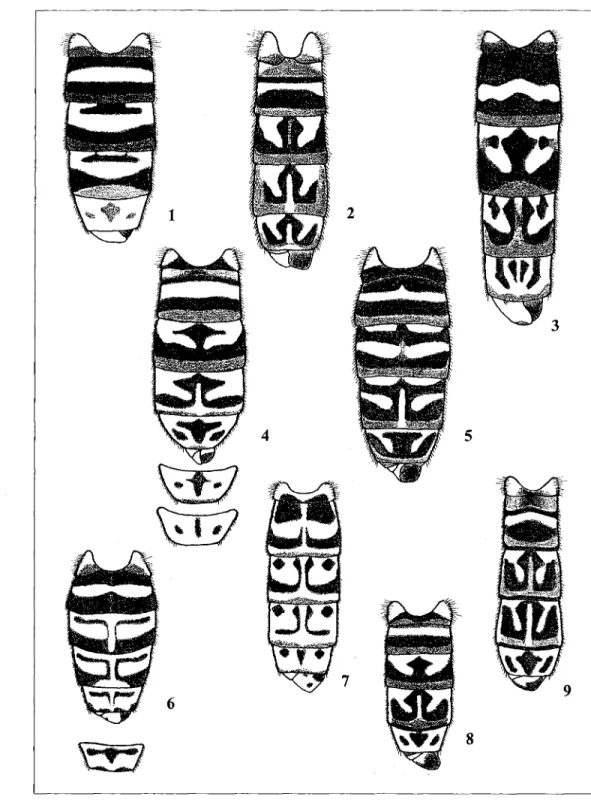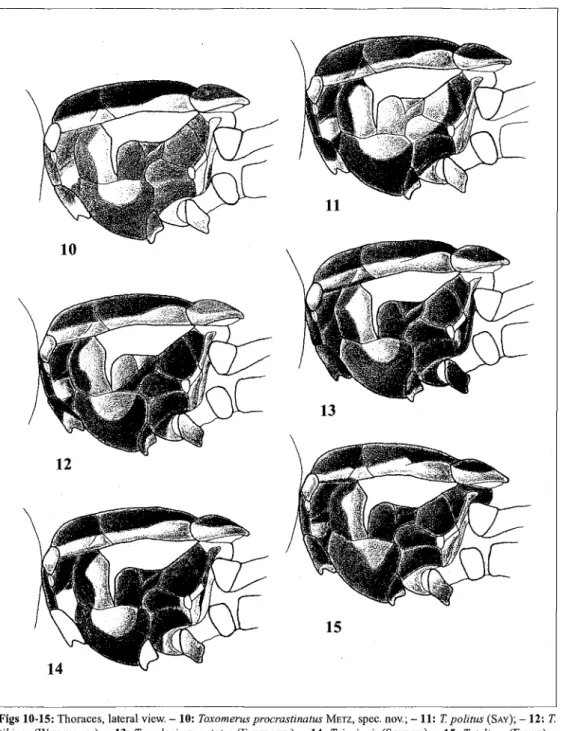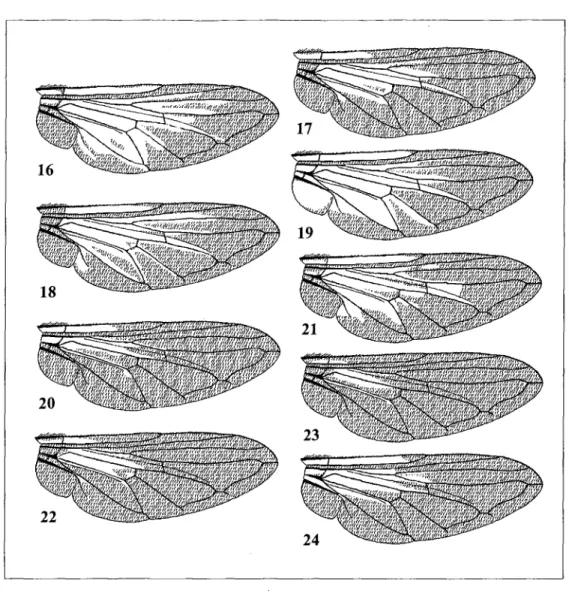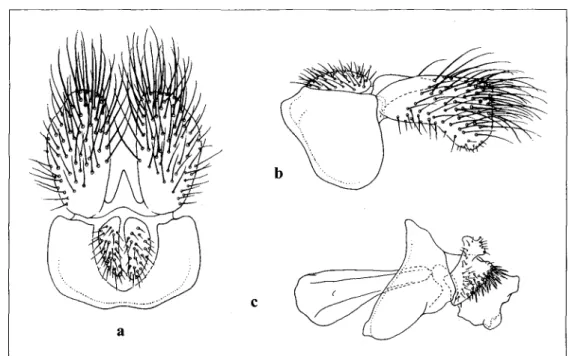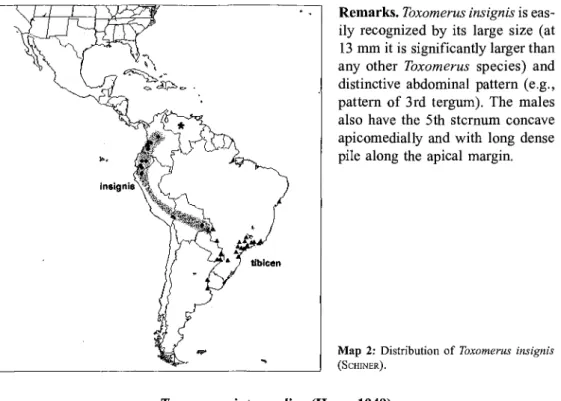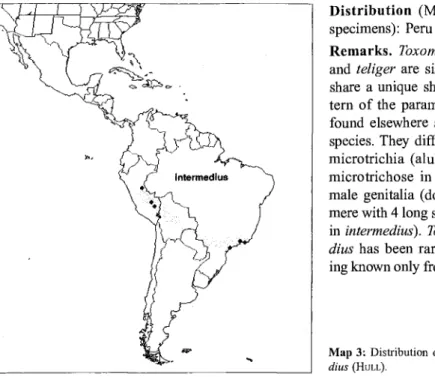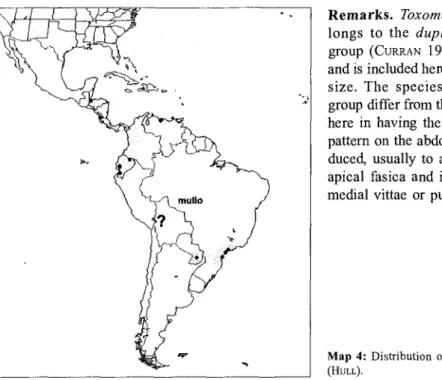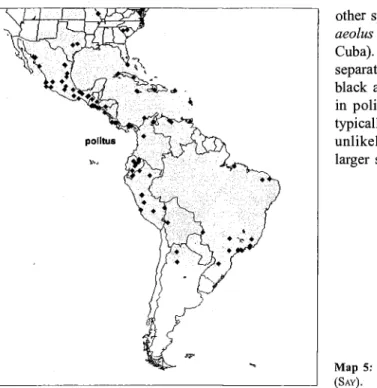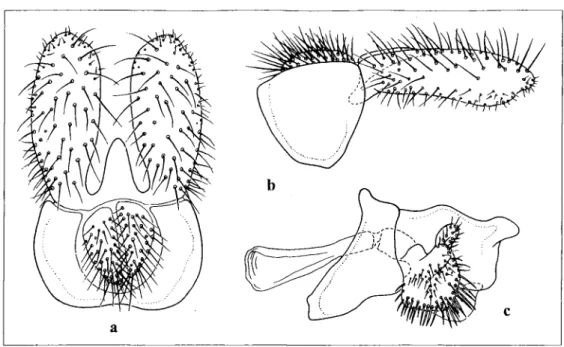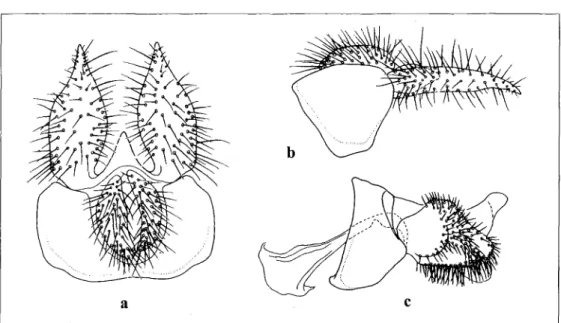A revision of the larger species of Toxomerus (Diptera: Syrphidae) with description of a new species
[Revision der grofieren Toxomerus-Arten (Diptera: Syrphidae) nebst der Beschreibung einer neuen Spezies]
by
Mark A. METZ and F. Christian THOMPSON
Urbana (USA) Washington (USA)
Abstract The larger species (9 mm or greater) of Toxomerus are revised: 1 new species is described [Toxomerusprocrastinates METZ spec. nov. (Brazil, Paraguay, Argentina)]; 6 names are syn- onymized [interruptus ENDERLEIN, 1938 (praeocc.) = aquilinus SACK, 1941; elongatus HULL,
1941 = insignis SCHINER, 1868; limae BRETHES, 1920 & 1937 &flava HULL, 1941 = saphiridiceps
BIGOT 1884; sinuatinevris MACQUART, 1855 & ornatus SACK 1941 = tibicen WIEDEMANN, 1830)];
8 lectotypes designated; 1 neotype is designated; figures are given of thoracic and abdominal color pattern, male genitalia and diagrams of wing microtrichia. The genus-group name Hybobathus ENDERLEIN 1938 is synonymized with Ocyptamus and its type-species transferred to Ocyptamus.
Key words Neotropis, key
Zusammenfassung Die grofieren Toxomerus Arten mit einer Korperlange von mehr als 9 mm werden revidiert.
Die Ergebnisse lassen sich wie folgt zusammenfassen: Beschreibung einer neuen Art [Toxomerus procrastinates METZ spec. nov. (Brasilien, Paraguay, Argentinien)]; Syno- nymisierung von 6 Namen [interruptus ENDERLEIN, 1938 (praeocc.) = aquilinus SACK, 1941;
elongatus HULL, 1941 = insignis SCHINER, 1868; limae BRETHES, 1920 & 1937 &.flava HULL,
1941 = saphiridiceps BIGOT 1884; sinuatinevris MACQUART, 1855 & ornatus SACK 1941 = tibicen
WIEDEMANN, 1830)]. Weiterhin werden 8 Lectotpen und 1 Neotypus festgelegt. Von den Arten werden die Farbungsmuster des seitlichen Thorax und des Abdomens, der Bau der mannlichen Genitalien und die Verteilung der Microtrichien auf den Flugeln abebildet. Der Name der Gattungsgruppe Hybobathus ENDERLEIN, 1938 wird mit Ocyptamus synonymisiert und die Typusart des erstgenannten Genus in Ocyptamus eingefiigt.
Stichworter Neotropis, Bestimmungsschhissel
Introduction
What do we really know about tropical biodiversity? Recent evidence supports the notion that the number of described species probably represents only a small fraction of what occurs in the tropics (JANZEN 1987, GASTON 1994). Scientists aware of the need to explore these unknown regions have attacked the situation with fervor. For example, Costa Rica has established a Na- tional Biodiversity Institute (INBIO) to assess the country's biodiversity. The result of this survey will be the most thorough assessment of tropical diversity for any single country. Approximately 500,000 species of biological organisms occur in Costa Rica, a dramatic number for a country of such small size. However, probably less than 80 % of the plants and less than 20 % of the arthropods of Costa Rica have been named and/or described. Some tropical researchers realize the futility of ecological or environmental studies without a working knowledge of the composi- tion of species in an ecosystem (ROSSMAN & MILLER 1996). As world biodiversity issues become commonplace in national and international politics, the need for accurate knowledge becomes crucial to intellectualize the debate over development of sustainable ecosystems.
The inventory of species diversity is only the first step in creating a user-friendly "work place" for tropical biologists. Following formal taxonomic monographs and descriptions of numerous new species, tools for identification need to be created and maintained. Systema- tists often neglect the need of the more common, "non-systematist" user, a simple way to identify organisms encountered in their studies. Complicated keys requiring an understand- ing of often complex morphological terms delays the projected goal of understanding tropi- cal biology by causing user frustration and misidentifications. Simple keys, utilizing easily understood characters such as size, distribution, and color that are extensively illustrated are more cogent and effective. Also, we have economically designed our keys (see THOMPSON
1999b: 323) and have included additional characters in couplets where they are useful.
In addition to our attempt at utility is our concern with accessibility of this work. By trying to meet the needs of the end user, a formal and traditional version is here presented, however, the information has also been re-formatted so as to be available on the World-Wide-Web (WWW). The WWW version includes greater content than the traditional format due to lower costs of making it available. Color habitus pictures for all species are available as well as complete specimen label data and facsimiles of original descriptions for all names. The WWW version can be found at the Systematic Entomology Laboratory site (http://
www.sel.barc.usda.gov) under the Diptera section [and a copy is also distributed on the Diptera Data Dissemination Disk, a CD-ROM publication (see THOMPSON 1996)].
Toxomerus species are the most abundant flower flies in the New World. In the North, the most common and widespread species is Toxomerus marginatus (SAY), a polyvoltine species, abundant everywhere from spring through fall. In the tropics, Toxomerus dispar (FABRICIUS)
is the common widespread species, but in some areas, species such as T.pulchellus (MACQUART)
are more abundant. The immature stages of Toxomerus are not well known. One common and widespread species (politus) is found in close association with corn (Zea mays L.) and the adult and presumably the larva feed on the pollen of that plant (MARIN A. 1969). All other species for which data are available are predaceous as larvae, feeding on aphids (BANKS et al.
1916: 184; HEISS 1938: 30). Larvae and puparia are easily recognized by the characteristic arrangement of the hind spiracular openings (Figs 34-38).
Materials and methods
THOMPSON (1999b) provides a key to the Neotropical genera of flower flies and a glossary of taxonomic terms; this terminology is followed here. Normal sexual dimorphism in Toxomerus includes the male being holoptic, having a yellow frons and a more linear abdomen, while the female is dichoptic, having a broad, shiny black median vitta on the frons and a more oval abdomen. Synonymies follow the standards used by the BioSystematic Database of World Diptera (see THOMPSON 1999a); a key to the abbreviations used can be found in the Nearctic Flower Flies (THOMPSON 2000a). Specimens were barcoded and label data were entered into a FileMakerPro database. Maps were generated from these data using VersaMap
(CULBERSON 2000). Specimen label data are not included, but are available from the Diptera WWW site (see above) and are on the Diptera Data Dissemination Disk (THOMPSON 2000b).
The number of specimens examined and their general localities are indicated in our distribu- tion statement. In our drawings of the abdominal pattern we have followed the conventions of HULL (1943: 28), wherein, for example, the shiny black apical fasciae are shown as gray stippling.
Toxomerus MACQUART, 1855
Toxomerus MACQUART, 1855: 93, notatus MACQUART (original designation) = geminatus SAY.
Mesogramma LOEW, 1866: 157, parvula LOEW (WILLISTON 1887: 98). Preocc. STEPHENS 1850.
Mesograpta LOEW, 1872: 114, unnecessary new name for Mesogramma. Synonymy by OSTEN SACKEN 1878: 125.
Mitrosphen ENDERLEIN, 1938: 227, Syrphus tibicen WIEDEMANN (original designation). Synonymy by HULL 1949b: 290.
Antiops ENDERLEIN, 1938: 228, Mesograpta saphiridiceps BIGOT (original designation). Synonymy by HULL 1949b: 290.
LOEW described Mesogramma as similar to Sphaerophoria but differing in the mesonotal pattern and the elongate vertical triangle of the males. He later renamed Mesogramma, Mesograpta because Mesogramma had been used for a group of plants. OSTEN SACKEN (1878:
48, 1878: 125) recognized that Mesograpta and Toxomerus were names for the same taxon, but used the junior name Mesograpta). WILLISTON (1887: 98) followed OSTEN SACKEN'S treat- ment, but later he (WILLISTON 1891: 24) recognized Mesogramma rejecting LOEW'S argument of preoccupation in Botanical Nomenclature. Unfortunately, the name Mesogramma has also been used in Zoology by STEPHENS (1850: 183) for a moth. ALDRICH (1905: 370) fol- lowed WILLISTON. KERTESZ (1910: 143) followed OSTEN SACKEN and subsequent workers in recognition of a single taxon, but used the senior name, Toxomerus. ENDERLEIN (1938: 212) established a tribe for Toxomerus and 8 other genera [Chasmia (=Allograpta), Allograpta, Allograptina (=Rhysops), Antiops (=Toxomerus), Hybobathus (=Ocyptamus), Mitrosphen (=Toxomerus), Toxomerus, Mesogramma (=Toxomerus), Ocyptamus & Atrichosticha (=Melanostoma)] on the basis of the reduced marginal pile of the calypter and reduced plumula. Not only was this tribe a mish-mash of genera from the tribes Syrphini, Bacchini and Toxomerini, four of his included genera contained a mixture of species from different tribes! HULL (1949b: 286) used Mesogramma as the valid name and was the first subsequent worker to treat the names of ENDERLEIN. HULL (1949b: 288) considered Hybobathus as a valid subgenus of Mesogramma, but did not recognize Mitrosphen and Antiops. WIRTH et al. (1965:
570) used Mesograpta instead of Mesogramma and treated Toxomerus as a separate genus.
VOCKEROTH (1969: 12) recognized the tribe Toxomerini, but as including only one genus, which is the treatment we follow here. VOCKEROTH was uncertain as to the placement of Hybobathus as he had not seen specimens. The holotype of Hybobathus quadrilineatus
ENDERLEIN (ENDERLEIN 1938: 233, type in ZMHU) is a specimen of Ocyptamus, hence the name is a new synonym of Ocyptamus.
Little revisionary work beyond the description of new species has been done on Toxomerus.
CURRAN (1930) was the first to publish a comprehensive key to species (included only 42 species) and was followed by HULL (1943, included 97 species). However, neither key in- cluded all known species. Since then additional species have been named (GERDES 1975a;
HARBACH 1974, 1984; HULL 1951; THOMPSON 1981). THOMPSON (1981) provided a key to the West Indian species and GERDES (1975b) provided notes on types. The last comprehensive listing of names for the genus was in THOMPSON et al. (1976). At the present time, there are some 143 valid names. Many names have not been recognized subsequent to their descrip- tion and may be synonyms. Meanwhile, many new undescribed species have already been segregated in collections.
Most of the larger species of Toxomerus (aquilinus, insignis, intermedius, procrastinatus, saphiridiceps, teliger, tibicen & undecimpunctatus, but not mulio, politus & valdesi) prob- ably represent a distinct clade within Toxomerus. ENDERLEIN created two names for this clade {Mitrosphen & Antiops), but without an analysis of Toxomerus as a whole the status of these names can not be determined. The characters which may be useful for defining this clade
are: elongate narrow frontal triangle of the male, anterior position of ocellar triangle, raised ventral area of frons in female (which we here call the "ventral swelling") and more sinuate R4+5 vein.
Key to the larger (greater than 9 mm long) species of Toxomerus
1 Supraprocoxal yellow macula absent (Fig. 14); 8 4th sternum strongly concave medi- ally, with long apicolateral pile (Fig. 26). Alula mictrichose (Fig. 17); anepimeron black insignis
- Supraprocoxal yellow macula present (Figs 10-13, 15); 8 4th sternum not as such 2 2 Alula almost entirely bare (Fig. 21). Anepimeron black teliger - Alula entirely microtrichose (Figs 16-20, 22-24) 3 3 Anepimeron completely yellow or orange (Figs 10 & 13) 10 - Anepimeron partly or completely black (Figs 11-12, 14-15) 4 4 Metatibia yellow, with distinct basal and apical black annulae valdesi - Metatibia yellow, brown, or black, with no distinct annulae 5 5 8 postanal process distinct, at least 1/3 as long as surstylus (Figs 28, 29); anepimeron bicolorous, yellow dorsally, black ventrally (Fig. 11) OR 3rd tergum with a continuous black fascia on basal 1/2 (Fig. 6) 8 - 8 postanal process indistinct (Figs. 25, 27, 32); anepimeron unicolorous, completely black (Figs 12, 14, 15); 3rd tergum without a continuous black fascia on basal 1/2 (Figs 2, 4) 6 6 3rd and 4th terga with apical black area transverse, neither curved anteriorly nor ex- tending to base laterally (Fig. 4) aquitinus - 3rd and 4th terga with apical black area curved anteriorly and extending almost or to base laterally (Fig. 2) 7 7 Abdomen with yellow maculae on 3rd & 4th terga isolated from lateral margins (Fig. 2);
calypter with brownish black fringe on basal 1/3 tibicen - Abdomen with yellow maculae on 3rd & 4th terga broadly extending to lateral margin;
calypter entirely yellow intermedius 8 3rd and 4th terga yellow on basal 2/3, with narrow black subbasal fascia connected to medial vitta to form L-shaped macula, but isolated laterally (Fig. 6). 8 postanal proc- ess about 1/3 as long as surstylus; antenna yellow; scutellum yellow, at most obscurely brownish on disc (Fig. 11) politus - 3rd and 4th terga without such a macula, with subbasal fascia continuous and extend- ing to lateral margins (Fig. 5) 9 9 Antenna yellow; scutellum yellow, at most obscurely brownish on disc; 8 postanal process about 3/4 as long as surstylus (Fig. 28) mulio - Antenna black; scutellum black with yellow apical margin; 8 postanal process shorter, about 1/3 as long as surstylus (Fig. 30) saphiridiceps 10 Thoracic pleura orange and yellow; anepimeron, katepimeron and katatergum orange (Fig. 10); abdominal pattern without isolated puncta on terga 3-5 (Fig. 9); 8 postanal process long, at least half as long as surstylus (Fig. 29) procrastinatus - Thoracic pleura black and yellow; anepimeron, katepimeron and katatergum entirely or extensively yellow (Fig. 13); abdominal pattern with isolated puncta on terga 3-5 (Fig. 7);
8 postanal process short, about as wide as long (Fig. 33) undecimpunctatus
Figs 1-9: Abdominal patterns, dorsal view. - 1: Toxomerus valdesi (FLUKE); - 2: T. tibicen (WIEDEMANN); - 3: T.
insignis (SCHINER); - 4: T. aquilinus SACK; - 5: T. saphiridiceps (BIGOT); - 6: T.politus (SAY); -1:T. undecimpunctatus
(ENDERLEIN); -8:77 teliger (FLUKE); - 9: T. procrastinatus METZ, spec. nov.
Figs 10-15: Thoraces, lateral view. - 10: Toxomerusprocrastinatus METZ, spec, nov.; - 11: T. politus (SAY); - 12: T.
tibicen (WIEDEMANN); - 13: T. undecimpunctatus (ENDERLEIN); - 14: T. insignis (SCHINER); - 15: T. teliger (FLUKE).
Legend to the figures of page 231 -*-
Figs 16-24: Wing microtrichia diagrams. These are not actual figures of the wings of the various species, but schematic wings with the distribution of the microtrichia shown. - 16: Toxomerus aquilinus SACK; - 17: T. insignis (SCHINER); - 18: T. politus (SAY);- 19: T. procrastinatus METZ, spec, nov.;-20: T. saphiridiceps (BIGOT); -21: T. teliger (FLUKE);
- 22: T. tibicen (WIEDEMANN); - 23: T undecimpunctatus (ENDERLEIN); - 24: T. valdesi (FLUKE).
Toxomerus aquilinus SACK, 1941
Fig. 4 (abdomen), Fig. 16 (wing), Fig. 25 (male genitalia), Map 1
Toxomerus aquilinus SACK, 1941: 100 (1951: 96), Fig. 2 (abdomen). Peru, "Pichis, Puerto Yessup." LT S SMT here designated. FLUKE 1956: 157 (cat. cit.); THOMPSON et al. 1976:48 (cat. cit). Synonymy by THOMPSON etal. 1976:48.
Mitrosphen interruptus ENDERLEIN, 1938: 227. Colombia, Cordillera. LT o* ZMHU here designated. Junior second- ary homonyn, preoccuppied by Syrphus interruptus PHILIP 1865. syn. nov.
Mesograpta interruptus. FLUKE 1956: 224 (cat. cit.).
anchoratus of: ?SCHINER 1868: 348 (South America); ?OSTEN SACKEN 1878: 125 (cat. cit.); WILLISTON 1886: 313 (cat.
cit), 1888: 265 (Brazil); KERTESZ 1910: 149 (in part, cat. cit.); CURRAN 1930: 3 (key ref.); HULL 1943: 9, 35 (key ref., abdomen* [see footnote]); FLUKE 1956: 217 (cat. cit.).
Male. Head: Face yellow, white pollinose and white pilose laterally, bare and shiny medi- ally; gena yellow; frontal lunule yellow, with reddish-brown macula medially; frontal trian- gle yellow narrowly white pollinose posteriorly, white pilose except black pilose anteromedially; eyes narrowly holoptic anteriorly; vertical triangle black, silvery pollinose anterior to ocellar triangle, shiny black posterior to ocellar triangle except brownish-yellow
If the cited literature contains figures an asterisk (*) is added.
Fig.25a-c: Male genitalia, Toxomerus aquilinus SACK. - a: dorsal view of 9th tergum and associated structures; - b:
lateral view of 9th tergum and associated structure; - c: lateral view of 9th sternum and associated structures.
pollinose at juncture with occiput, black pilose; occiput black except yellow ventrally, silver pollinose, white pilose except dorsal 1/4 black pilose anteriorly; scape and pedicel yellow, black pilose; basoflagellomere orange; labium black; labellum yellow.
Thorax: Generally black, yellow as follows: postpronotum, scutum laterally and continu- ously from postpronotum to scutellum, dorsad of procoxa (i.e., supraprocoxal macula), pos- terior half of posterior anepisternum, dorsolateral macula on katepisternum, ventrolateral metasternum, metapleuron; silver-gray pollinose; white pilose ventrally and laterally except posterior anepisternum yellow pilose, yellow pilose dorsally except postalar callus with in- termixed black pile. Scutum greenish-bronze pollinose with narrow medial shiny vitta, sub- medial silver gray pollinose vittae; scutellum brown with yellow margin, black pilose;
subscutellar fringe white; halter yellowish-orange, brownish at base; calypter yellow except brown on dorsal margin; plumula yellow. Legs: pro- and mesocoxae black except orange on apical 1/4, yellow pilose; metacoxa black, yellow pilose; trochanters yellow, yellow pilose;
pro- and mesofemora yellow, yellow pilose; metafemur yellow except apical 1/3 black, yel- low pilose except apical 1/3 black pilose; pro- and mesotibiae yellow, yellow pilose; metatibia brown-brownish black, black pilose; tarsi dorsally brown-brownish black, black pilose, ventrally yellow, yellow pilose. Wing: Hyaline except for dark stigma, extensively microtrichose, bare as figured (Fig 16).
Abdomen (Fig. 4): Sterna yellow, yellow pilose; terga black pilose except yellow pilose laterally on first and basal 1/4 of second; tergum 1 black except yellow anteriorly and later- ally; tergum 2 black and black pollinose with slightly arcuate yellow, medial fascia and
\jj I )\A4?y
\ll ^Y&
\ / " «qulllnu«\
brownish-orange shiny fascia basally and apically; tergum 3 black and black pollinose with sub-lateral ar- cuate yellow vitta continuous to ba- sal border and brown shiny apical fascia; tergum 4 black and black pollinose with sub-lateral arcuate yellow vitta continuous to basal bor- der, narrow, yellow medial vittae and brown shiny apical fascia; tergum 5 yellow, with variable black medial and submedial maculae, with medial macula ranging from large T-shaped to linear vitta and submedial macu- lae from quadrate maculae to puncta, sometimes with narrow apical brown- ish to black fascia; male genitalia as figured (Fig. 25).
Map 1: Distribution of Toxomerus aquilinus
SACK.
Female. Similar to male except normal sexual dimorphism and face brown medially; frontal lunule completely yellow; frons produced anteriorly as a "ventral swelling" at antennal bases, broadly black medially, black pilose.
Length. Body, 9.6-11.5 (10.7); wing, 7.2-8.6 (7.9) mm.
Types: Toxomerus aquilinus was described from an unspecified number of males and females from Peru and Bolivia in the collection of SCHNUSE. A male syntype labeled "Peru-Pichis, 25-12-03, Pto. Yessup," "Coll. W. SCHNUSE, 1911-3,"
"Toxomerus aquilinus SACK, n. spec." [in SACK'S hand] is here designated lectotype and has been so labelled. This lectotype designation is made in order to fix the concept of aquilinus and to ensure universal and consistent inter- pretation of the same. An additional 8 specimens were labeled as paralectotypes.
Mitrosphen interruptus was described from a series of 3 S 8 and 2 9 9 syntypes. A male syntype labeled "Cordill v. Col umbien, terre caliente, THIEME S." [green], "Typus," "Mitrosphen, interruptus, Type, ENDERL., Dr. ENDERLEIN
det. 1937," is here designated as lectotype and has so been labelled. This lectotype designation is made in order to fix the concept of interruptus and to ensure universal and consistent interpretation of the same. The male genitalia figure was made from the paralectotype from Mexico.
Distribution (Map 1 based on 111 specimens): Mexico (1), Panama (19), Venezuela (3), Ecuador (1), Peru (9), Bolivia (10) and Brazil (68).
Remarks. The northern most record for aquilinus is based on a syntype (paralectotype) of interruptus labelled as collected in "Mexiko, Jacuapam" by "S. V PURPUS." There is no such locality in Mexico. While hard to believe, "Jacuapam" is a transcription error for what was Zacualpan Hacienda in Veracruz where a pair of German brothers, C. A. and S. V PURPUS,
collected extensively in the early part of the last century (1900-1940). This hacienda was huge, ranging from the costal plain to the high cloud forests in the mountains. After the revolution, the big hacienda was broken up into several municipalities, one of which is called Zacualpan (98W, 20N) and is the point we have used for this specimen.
WILLISTON (1888: 265) misapplied the name anchoratus to this species and was followed by
CURRAN and HULL. His specimens from Brazil, Chapada, are in New York (AMNH).
Toxomerus aquilinus, intermedius, teliger and tibicen have been frequently confused given the identifications we have seen in collections. All these species appear similar. Of the four, aquilinus is readily distinguished by the black subapical fasciae on the 3rd and 4th terga being nearly straight so that the lateral margin on the basal 1/2 is pale (Fig. 4). The other species have the black fasciae extending anterolaterally so that the lateral margin is black along most of its length (Figs 2, 8).
Toxomerus insignis (SCHINER, 1868)
Fig. 3 (abdomen), Fig. 14 (thorax), Fig. 17 (wing), Fig. 26 (male gentialia), Map 2
Mesogmmma insignis SCHINER, 1868: 347 pi. 4, Fig. 7 (habitus, head). "South America" [= Venezuela]. LT 3 NMW here designated. HULL 1943: 9 (key ref.).
Mesograpta insignis WILLISTON, 1886: 313 (cat. cit); FLUKE 1956: 223 (cat. cit.).
Toxomerus insignis KERTESZ, 1910: 146 (cat. cit); THOMPSON et al. 1976: 51 (cat. cit.).
Mesogmmma elongata HULL, 1941a: 46. Colombia, Muzo, Dept. Boyaca. LT 3 MCZ here designated. HULL 1943:
9, 35 (key ref., abdomen*); COOPER & CUMMING 1993: 63 (syntypes in CNC). syn. nov.
Mesograpta elongata FLUKE 1956: 222 (cat. cit.).
Toxomerus elongatus THOMPSON et al. 1976: 50 (cat. cit.).
Male. Head: Face yellow, white pollinose and white pilose laterally, bare and shiny medi- ally; fena black; frontal lunule yellow, with reddish-brown macula medially; frontal triangle yellow narrowly white pollinose posteriorly, white pilose except black pilose anteromedially;
eyes narrowly holoptic anteriorly; vertical triangle black, silver-bronze pollinose anterior to ocellar triangle, shiny black posterior to ocellar triangle except brownish-yellow pollinose at juncture with occiput, black pilose; occiput black, silver pollinose, white pilose except dor- sal 1/4 black pilose anteriorly; scape and pedicel yellow, black pilose; basoflagellomere orange; labium black; labellum yellow.
Thorax (Fig. 14): Generally black, yellow as follows: postpronotum, scutum laterally and continuously from postpronotum to scutellum, posterior half of posterior anepisternum, dor- solateral macula on katepisternum, anterodorsal macula on metapleuron; silver-gray pollinose;
white pilose ventrally and laterally except posterior anepisternum yellow pilose, yellow pilose dorsally except postalar callus with intermixed black pile. Scutum greenish-bronze pollinose with narrow medial shiny vitta, submedial silver gray pollinose vittae; scutellum brown with yellow margin, black pilose; subscutellar fringe white; halter yellow, brownish at base; calypter yellow except brown on dorsal margin; plumula yellow. Legs: all coxae black, yellow pilose;
trochanters brownish-yellow, yellow pilose; pro- and mesofemora brownish-yellow except dorsoapical 1/3 brown, yellow pilose except apical 1/2 mesofemur black pilose; metafemur yellow except black on apical 1/3, black pilose; pro- and mesotibiae yellow, yellow pilose;
metatibia black except yellow on apical 1/3, yellow pilose ventrally and black pilose dorsally;
tarsi dorsally brown-brownish black, black pilose, ventrally yellow, yellow pilose. Wing:
Hyaline except for dark stigma, extensively microtrichose, bare as figured (Fig. 17).
Abdomen (Fig. 3): Sterna yellow, yellow pilose (densely pilose on apical sterna); terga black pilose except yellow pilose laterally on first and basal 1/4 of second; tergum 1 black except yellow anteriorly and laterally; tergum 2 black and black pollinose with a narrow, yellow, medial fascia; tergum 3 yellow with sub-lateral black macula and black medial vitta continu- ous to apical border widening laterally at lateral border; tergum 4 yellow, with sublateral black macula isolated, with submedial black vitta continous to apical border widening laterally;
tergum 5 yellow with sublateral arcuate, black macula and submedial black vitta isolated from apical border and black lateral borders; male genitalia as figured (Fig. 26).
Fig. 26a-c: Male genitalia, Toxomerus insignis (SCHINER). - a: dorsal view of 9th tergum and associated structures;
- b: lateral view of 9th tergum and associated structure; - c: lateral view of 9th sternum and associated structures.
Female. Similar to male except normal sexual dimorphism and face brown medially; frons produced anteriorly as a „ventrall swelling" at antennal bases, broadly black medially, black pilose; antennae brown, black pilose. Legs: Pro- and mesofemora yellow except for apical 1/3 brown, yellow pilose except dorsoapical 1/3 black pilose. Abdomen: Apical sterna less densely pilose.
Length. Body, 13.0-13.7 (13.3); wing, 8.4-9.7 (9.0) mm.
Types: Mesogramma insignis was described from "ein(em) Parchen aus Siid-Amerikas." A pair labelled
"Mesogramma, insignis SCHIN" [= in SCHINER's hand], "LINDIO, 1864, Venezuela" and "insignis, Alte Sammlung," is present in Vienna. The male has the abdomen beyond the 3rd tergum missing. The female specimen is here desig- nated lectotype and has so been labelled. This lectotype designation is made in order to fix the concept of insignis and to ensure universal and consistent interpretation of the same;
Mesogramma elongata is based on "3" male cotypes from Colombia, two of which are now in the Canadian Na- tional Collection. A male cotype is here designated lectotype and is of the same species as lectotype of insignis. The lectotype is labeled as follows: "Muzo, Dept. Boyaca, alt. 900 m;" "Colombia, 1936;" "J. BEQUAERT, Collector;"
"Cotype, elongata, HULL" [light purple hand written label in HULL'S hand], "Mesogramma, elongata, nsp." [in pencil on a determination label written in HULL'S hand], and "SYNTYPE, Mesogramma, elongata, HULL, CNC NO. 10634."
As previously discussed (THOMPSON 1981: 16) there are numerous problems with HULL types supposedly deposited in the Museum of Comparative Zoology. The situation of elongata represents another one. While HULL stated the name was based on "3" cotypes, one of which was deposited in the MCZ, there is no evidence that that third cotype ever existed. Nathan BANKS was very careful about logging in new types received, but there is no record of elongata in the type catalog. Also, there are no unlabeled specimens of this species in the MCZ. We suspect HULL merely thought he had left behind a type in the MCZ as he usually did. The original material was collected by BEQUAERT, a Harvard professor, and, hence, is properly MCZ material. Traditionally, authors are entitled to a portion of the series when they describe new species, so one of the cotypes should belong to the MCZ. Unfortunately the CNC is not responsible for HULL'S behavior and, hence, is unwilling to correct historical mistakes.
Distribution (Map 2 based on 15 specimens): Colombia (7), Ecuador (5), Venezuela (1) and Bolivia (1).
Remarks. Toxomerus insignis is eas- ily recognized by its large size (at 13 mm it is significantly larger than any other Toxomerus species) and distinctive abdominal pattern (e.g., pattern of 3rd tergum). The males also have the 5th sternum concave apicomedially and with long dense pile along the apical margin.
Map 2: Distribution of Toxomerus insignis
(SCHINER).
Toxomerus intermedius (HULL, 1949)
Fig. 27 (male genitalia), Map 3. .
Mesogramma intermedia HULL, 1949a: 77. Peru, Pucallpa. HT 3 CNC. COOPER & CUMMING 1993: 63 (HT in CNC).
Mesograpta intermedia FLUKE 1956: 224 (cat. cit.).
Toxomerus intermedius THOMPSON et al. 1976: 51 (cat. cit.).
Male. Head: Face yellow, white pollinose and white pilose laterally, bare and shiny medi- ally; gena yellow except blackish dorsad of tentorial pit; frontal lunule yellow, with reddish-brown macula medially; frontal triangle yellow, narrowly white pollinose posteriorly, white pilose; eyes holoptic anteriorly; vertical triangle black, silvery pollinose anterior to ocellar triangle, shiny black posterior to ocellar triangle except brownish-yellow pollinose at juncture with occiput, black pilose; occiput black except yellow ventrally, silver pollinose except more yellowish on dorsal 1/3, white pilose except for a few black pili dorsally; an- tenna yellow, black pilose; labium black; labellum yellow.
Thorax: Generally black, yellow as follows: postpronotum, scutum laterally and continu- ously from postpronotum to scutellum, dorsad of procoxa (i.e., supraprocoxal macula), pos- terior half of posterior anepisternum, dorsolateral macula on katepisternum, metasternum, metapleuron; silver-gray pollinose; white pilose ventrally and laterally except posterior anepisternum yellow pilose, yellow pilose dorsally except postalar callus with intermixed black pile. Scutum greenish-bronze pollinose with narrow medial shiny vitta, submedial silver gray pollinose vittae; scutellum brown with yellow margin, black pilose; subscutellar fringe white; halter yellow, brownish at base; calypter yellow except brown on dorsal mar- gin; plumula yellow. Legs: all coxae and trochanters yellow, yellow pilose; pro- and mesofemora yellow, yellow pilose except apical 1/3 black pilose; metafemur brown-brownish black except basal 1/3 yellow, black pilose except yellow pilose basally; pro- and mesotibiae yellow, yellow pilose; metatibia brown-brownish black, black pilose; tarsi dorsally
Fig.27a-c: Male genitalia, Toxomerus intermedius (HULL). - a: dorsal view of 9th tergum and associated structures;
— b: lateral view of 9th tergum and associated structure; — c: lateral view of 9th sternum and associated structures, posterior view of paramere.
brown-brownish black except basotarsomeres paler on basal 2/3, black pilose, ventrally yel- low, yellow pilose. Wing: Hyaline except for dark stigma, extensively microtrichose, bare as figured for saphiridiceps (Fig. 20).
Abdomen: Sterna yellow, yellow pilose; terga black pilose except yellow pilose laterally on first, basal 1/4 of second and basolateral corners of other terga; tergum 1 black except yel- low anteriorly and laterally; tergum 2 black and black pollinose, with basolateral corners yellow and a narrow, slightly arcuate yellow, medial fascia widening laterally, and brown shiny fascia apically; tergum 3 black, black pollinose with sub-lateral arcuate (C-shaped) yellow vitta continuous to basal border but isolated from lateral margin and narrow, yellow medial vitta and brown shiny apical fascia; tergum 4 similar to 3rd except C-shaped vitta expanded basolaterally to extend over lateral margin on basal 1/4; tergum 5 yellow, narrowly brown apically, with medial and subapicolateral brownish black maculae; male genitalia as figured (Fig. 27).
Female. Similar to male except normal sexual dimorphism and face brown medially;
basoflagellomere brownish black on dorsal 2/3; frontal lunule completely yellow; frons pro- duced anteriorly as a "ventral swelling" at antennal bases, broadly black medially, black pilose; wing with 2nd costal cell usually more extensively microtrichose (see below); 5th tergum with dark maculae united to form sinuate apical fascia.
Length. Body, 9.6-10.4 (10.0); wing, 7.6-8.2 (7.8) mm.
Types: Mesogramma intermedia was based on a holotype female from Peru. This specimen is now in the Canadian National Collection, has been examined, and has the following labels: "intermed, tibicen + anchorata," "Holotype, Mesogramma, intermedia, HULL [red, in HULL'S hand]" and "Holotype, Mesogramma, intermedia, HULL, CNC NO.
20476."
Distribution (Map 3 based on 8 specimens): Peru (5), Brazil (3).
Remarks. Toxomerus intermedius and teliger are sister species. They share a unique shape and setal pat- tern of the paramere, which is not found elsewhere among Toxomerus species. They differ mainly in wing microtrichia (alula bare in teliger, microtrichose in intermedius) and male genitalia (dorsal arm of para- mere with 4 long setae in teliger, two in intermedius), Toxomerus interme- dius has been rarely collected, be- ing known only from six collections.
Map 3: Distribution of Toxomerus interme- dius (HULL).
The Brazilian samples have the wing more extensively bare, with the 2nd costal cell almost completely bare as in tibicen, whereas in the Peruvian sample (Quincemil) the 2nd costal cell is densely microtichose on apical 1/3. In appearance, intermedius looks like aquilinus (q.v.) and related species. HULL'S name is very appropriate as the abdominal pattern of this species is truly intermediate between those of aquilinus and tibicen. These species differ only in the degree to which the black subapical fasciae bend anterolaterally restricting or separating the basomedial yellow areas from the lateral margin.
Toxomerus mulio (HULL, 1941)
Fig. 28 (male genitalia), Map 4.
Mesogramma mulio HULL, 1941b: 311. Brazil, Sao Paulo, Juquia. HT $ CNC. HULL 1943: 28 (key ref, abdomen*);
COOPER & CUMMINO 1993: 64 (HT in CNC).
Mesograpta mulio FLUKE 1956: 226 (cat. cit.).
Toxomerus mulio THOMPSON et al. 1976: 52 (cat. cit.)
Male. Head: Face yellow, white pollinose and white pilose laterally, bare and shiny medi- ally; gena black; frontal lunule yellow; frontal triangle yellow narrowly white pollinose posteriorly, white pilose; eyes holoptic anteriorly; vertical triangle black, silver-bronze pollinose anterior to ocellar triangle, shiny black posterior to ocellar triangle except brownish-yellow pollinose at juncture with occiput, black pilose; occiput black, silver pollinose, white pilose except for a few black pili dorsally; scape and pedicel yellow, black pilose; basoflagellomere orange; labium black; labellum yellow.
Thorax: Generally black, yellow as follows: postpronotum, scutum laterally and continu- ously from postpronotum to scutellum, posterior half of posterior anepisternum, dorsola- teral macula on katepisternum, dorsomedial triangular area of anepimeron, anterodorsal macula on metapleuron; silver-gray pollinose; white pilose ventrally and laterally except posterior anepisternum yellow pilose, yellow pilose dorsally except postalar callus with in-
Fig.28a-c: Male genitalia, Toxomerus mulio (HULL). - a: dorsal view of 9th tergum and associated structures;
lateral view of 9th tergum and associated structure; - c: lateral view of 9th sternum and associated structures.
b:
termixed black pile. Scutum greenish-bronze pollinose with narrow medial shiny vitta, sub- medial silver gray pollinose vittae; scutellum yellow, black pilose; subscutellar fringe yel- low; halter yellow; calypter yellow; plumula yellow. Legs: pro- and mesocoxae black on basal 2/3, yellow apically, yellow pilose; metacoxa yellow, yellow pilose; trochanters brownish-yellow, yellow pilose; pro- and mesofemora yellow, yellow pilose except apical 1/2 mesofemur black pilose; metafemur yellow except for indistinct blackish annulus on apical 1/3, black pilose; pro- and mesotibiae yellow, yellow pilose; metatibia yellow, black pilose except yellow pilose ventrally; pro- and mesotarsi yellow, black pilose; metatarsus dorsally brown-brownish black, black pilose, ventrally yellow, yellow pilose. Wing: Hyaline except for dark stigma, extensively microtrichose, bare as figured for politus (Fig. 18).
Abdomen: Sterna yellow, yellow pilose (densely pilose on apical sterna); terga black pilose except yellow pilose laterally on first and basal 1/4 of second; tergum 1 yellow except black apicomedially; tergum 2 black and black pollinose with a broad yellow medial fascia; terga 3 and 4 yellow with black apical fascia and black submedial vittae continuous with apical fascia and widening anteriorly to a knot and reaching only basal 1/3; tergum 5 yellow with medial black vitta on basal 2/3; male genitalia as figured (Fig. 28).
Female. Similar to male except for normal sexual dimorphism and frons not produced anteriorly, broadly black medially, yellow pilose, brownish-gray pollinose on black area.
Length. Body, 8.2-10.0 (9.1); wing, 6.3-7.6 (6.9) mm.
Types: Mesogramma mulio is based on a holotype from Brazil, now in the Canadian National Collection. The holotype has been examined and has the following labels: "1.151," "S. Paulo, Juquia, J. LANE Col." "Holotype, mulio, HULL" [red, in HULL'S hand],'''Mesogramma, mulio, HULL" [determination label], and "Holotype, Mesogramma, mulio, HULL, CNC NO 20479."
Distribution (Map 4 based on 17 specimens): Guatemala (1), Costa Rica (1), Ecuador (6), Venezuela (5), Brazil (3) and Paraguay (1).
Remarks. Toxomerus mulio be- longs to the duplicatus species group (CURRAN 1930, HULL 1943) and is included here due to its large size. The species of duplicatus group differ from the others treated here in having the black maculate pattern on the abdomen greatly re- duced, usually to a single straight apical fasica and incomplete sub- medial vittae or punctae.
Map 4: Distribution of Toxomerus mulio
(HULL).
Toxomerus politus (SAY, 1823)
Fig. 6 (abdomen), Fig. 11 (thorax), Fig. 18 (wing), Fig. 34 (larva -*- p. 252), Fig. 36 (hind spiracular plate
•*- p. 252), Fig. 35, 36 (puparium •*- p. 252), Map 5
Scaevapolitus SAY, 1823: 88. United States [^Virginia, Fairfax Co., near Annandale]. NT 3 USNM here designated.
Syrphuspolitus SAY 1824: 24 (descr., habitus*). WIEDEMANN 1830: 132 (descr.)
Mesogrammapolita LOEW 1866: 157 (note); ALDRICH 1905: 371 (cat. cit); CURRAN 1930: 2 (key ref.); HULL 1943: 6, 29 (key ref, abdomen*).
Mesograpta polita OSTEN SACKEN 1878: 125 (cat. cit.); WILLISTON 1887: 98 (descr.).
Meosgramma politum WILLISTON 1891: 25 (key ref., Mexico).
Toxomerus politus KERTESZ 1910: 149 (cat. cit.); SACK 1941: 104 (Peru); THOMPSON et al. 1976:53 (cat. cit.); THOMPSON
1981: 94 (abdomen* male genitalia* West Indies).
Mesograpta politum FLUKE 1956: 228 (cat. cit.).
Syrphus anchoratus MACQUART 1842: 97 [pi. 16, fig, 8 (habitus)]. Brazil. LT adult of unknown sex MNHN here designated. Synonymy by KERTESZ 1910: 149.
Mesograpta anchorata OSTEN SACKEN 1878: 125 (cat. cit., in part, also see aquilinus)
Syrphus cingulatulus MACQUART 1850: 459. Florida, Pensacola. LT $ UMO here designated. Synonymy by OSTEN SACKEN 1875: 48.
Syrphus hecticus JAENNICKE 1867: 398. Illinois. ST 8 SMF. Synonymy by OSTEN SACKEN 1875: 48.
Male. Head: Face yellow, white pollinose and white pilose laterally, bare and shiny medi- ally; gena yellow; frontal lunule yellow, with reddish-brown macula medially; frontal trian- gle yellow, white pilose; eyes narrowly holoptic anteriorly; vertical triangle black, bronze pollinose anterior to ocellar triangle, except shiny black posterior to ocellar triangle, black pilose; occiput black except narrowly yellow ventrally, silver pollinose, white pilose except dorsal 1/4 black pilose anteriorly; scape and pedicel yellow; basoflagellomere orange, yel- low pilose; labium black; labellum yellow.
Thorax (Fig. 11): Generally black, yellow as follows: postpronotum, scutum laterally and continuously from postpronotum to scutellum, dorsad of procoxa (i.e., supraprocoxal macula), posterior half of posterior anepisternum, dorsolateral macula on katepisternum, anterodorsal
macula on anepimeron, ventrolateral macula on metasternum, metapleuron; silver-gray pollinose; white pilose ventrally and laterally except posterior anepisternum yellow pilose, yellow pilose dorsally. Scutum greenish-bronze pollinose with narrow medial shiny vitta and sublateral shiny vittae; scutellum brown with yellow margin, black pilose; subscutellar fringe white; halter yellow; calypter yellow except brown on dorsal margin; plumula yellow. Legs:
pro- and mesocoxae black except yellow on apical 1/4, metacoxa yellow, yellow pilose; femora yellow, yellow pilose except meso- and metafemora apical 1/3 black pilose; tibiae yellow, yellow pilose except metatibia black pilose; tarsi yellow except distal metatarsi black dorsally, yellow pilose except distal metatarsi black pilose dorsally. Wing: Hyaline except for dark stigma, extensively microtrichose, bare as figured (Fig. 18).
Abdomen (Fig. 6): Sterna yellow, yellow pilose; terga mostly black pilose except yellow pilose laterally on first and basal 1/4 of second and with intermixed yellow pile; tergum 1 black except yellow anteriorly and laterally; tergum 2 black with a yellow, medial fascia; terga 3 and 4 yellow with sub-medial black vittae continuous to apical border and narrow, black sub-medial fascia discontinuous medially and black apical fascia; tergum 5 yellow, brown apically with medial black vittate macula which may be divided into submedial vittae and sub-lateral black fascia which are connected to medial or submedial vitta; male genitalia as figured (THOMPSON
1981: 81, Fig. 124).
Female. Similar to male except normal sexual dimorphism and face brown medially; frontal lunule completely yellow; frons broadly black medially except yellow maculae above anten- nae, black pilose anterolaterally; vertex completely bronze pollinose. Scape and pedicel with black pile; basoflagellomere brown. All metatarsi brown-black dorsally, black pilose dorsally.
Length. Body, 8.1-9.5 (8.8); wing, 6.3-7.3 (6.8) mm.
TVpes: Syrphus politus was described from an unspecified number of specimens from the United States, but later SAY
wrote that he had only two imperfect females. Like the rest of SAY'S collection, these specimens are lost. To ensure that this name continues to be properly and consistently interpreted, we here designated a male labelled "VA: Fairfax Co., near Annandale, VIII.31-IX.3, Malaise trap 81, David R. SMITH;" "TJSNM ENT 00020904," Neotype, Scaeva, polita,
SAY, THOMPSON '97" as neotype. The neotype is deposited in the United States National Collection, Washington.
Syrphus anchoratus was described from an unspecified series of males and females from Brazil and acquired for the Paris Museum by Sylveira. A single specimen labelled "Sylveira, Bresil, 1839" remains in Paris and is here designated lectotype. This lectotype designation is made in order to fix the concept of anchoratus and to ensure universal and consistent interpretation of the same. This specimen is merely a fragment of thorax with wings. Fortunately, the habitus given by MACQUART is clearly identifiable as the species now known as politus SAY as was first indicated by KERTESZ.
Syrphus cingulatulus MACQUART was described from an unspecified number of specimens from Pensacola, Florida in the BIGOT Collection. A female with the appropriate MACQUART / BIOOT label (see THOMPSON 1988: 201, Figs. 7, 11) in the VERRALL-COLLIN Collection at the University Museum, Oxford, is designated lectotype and has been so la- belled. This lectotype designation is made in order to fix the concept of cingulatulus and to ensure universal and consistent interpretation of the same.
Syrphus hecticus JAENNICKE was described from an unspecified number of females collected by Dr. REUSS in Illinois. J.
R. VOCKEROTH has examined the types in the Senckenberg Museum and confirmed OSTEN SACKEN'S synonymy.
Distribution (Map 5 based on 263 specimens): Canada (Ontario, Quebec), United States (Alabama, Arizona, Connecticut, District of Columbia, Florida, Georgia, Illinois, Iowa, In- diana, Kansas, Maryland, Massachusetts, Michigan, Mississippi, Missouri, New Jersey, New York, North Carolina, Pennsylvania, Rhode Island, South Carolina, Tennessee, Texas, West Virginia, Virginia), West Indies (Cuba (1), Jamaica (1), Haiti (1), Puerto Rico (1), Dominica (1)), Mexico (20), Guatamala (10), El Salvador (18), Honduras (3), Nicaragua (1), Costa Rica (4), Panama (5), Colombia (3), Venezuela (8), Trinidad (1), Ecuador (39), Peru (5), Bolivia (1), Brazil (63) and Argentina (2).
Remarks. Toxomerus politus is readily recognized by its abdominal pattern with the narrow submedial vittae bent into and continued as elongate fasciate maculae subbasally. The only
other species with such a pattern is aeolus HULL (Mexico, Costa Rica &
Cuba). Toxomerus aeolus is readily separated frompolitus by its entirely black anepimeron, partially yellow in politus. Both these species are typically less than 9 mm, and, hence, unlikely to be confused with the larger species treated here.
Map 5: Distribution of Toxomerus politus (SAY).
Toxomerus procrastinatus METZ, spec. nov.
Fig. 9 (abdomen), Fig. 10 (thorax), Fig. 19 (wing), Fig. 29 (male genitalia), Map 6
Male. Head: Face yellow, white pollinose and white pilose laterally, bare and shiny medi- ally; gena yellow; frontal lunule yellow; frontal triangle yellow narrowly white pollinose posteriorly, white pilose medially and black pilose anterolaterally; eyes narrowly holoptic anteriorly; vertical triangle black, silvery pollinose anterior to ocellar triangle, shiny black posterior to ocellar triangle except brownish-yellow pollinose at juncture with occiput, black pilose; occiput black except yellow ventrally, silver pollinose, white pilose except dorsal 1/4 black pilose anteriorly; scape and pedicel yellow, black pilose; basoflagellomere orange, white pollinose; labium black; labellum yellow.
Thorax (Fig. 10): Generally orange, yellow as follows: postpronotum, scutum laterally and continuously from postpronotum to scutellum, dorsad of procoxa (i.e., supraprocoxal macula), posterior half of posterior anepisternum, dorsolateral macula on katepisternum, metaster- num, metapleuron; silver-gray pollinose; yellow pilose except postalar callus with inter- mixed black pile. Scutum black, greenish-bronze pollinose with narrow medial and sub-lateral shiny vittae; scutellum orange with yellow margin, black pilose; subscutellar fringe white;
halter yellow, orange at base; calypter yellow; plumula yellow. Legs: pro- and mesocoxae orange basally and yellow apically, yellow pilose; metacoxa yellow, yellow pilose except black pilose laterally; trochanters yellow, yellow pilose except metatrochanter with black pile dorsally; pro- and mesofemora yellow, yellow pilose; metafemur brown except extreme base yellow, black pilose; pro- and mesotibiae yellow, yellow pilose except mesotibia black pilose on basal 1/4; metatibia brown, black pilose; tarsi yellow except metatarsi black dorsally, yellow pilose except metatarsus black pilose dorsally. Wing: Hyaline except for dark stigma, extensively microtrichose, bare as figured (Fig. 19).
Fig 29a-c: Male genitalia, Toxomerus procrastinalus METZ spec. nov. - a: dorsal view of 9th tergum and associated struc- tures; - b: lateral view of 9th tergum and associated structure; - c: lateral view of 9th sternum and associated structures.
Abdomen (Fig. 9): Sterna yellow, yellow pilose except sternum 5 sparsely black pilose later- ally; terga black pilose except yellow pilose laterally on first and basal 1/4 of second; tergum 1 orange except yellow anteriorly and laterally; tergum 2 brown and black pollinose with orange shiny fascia basally, a narrow, slightly arcuate yellow, medial fascia widening laterally, brown shiny fascia sub-apically and orange, shiny fascia apically; terga 3 and 4 brown with sub-lateral arcuate yellow vittae continuous to basal border and narrow, yellow medial vittae and orange shiny apical fasciae; tergum 5 yellow, orange apically with arcuate, sublateral brown vitta, and medial brown vitta continuous basally; male genitalia as figured (Fig. 29).
Female. Similar to male except normal sexual dimorphism and frons produced anteriorly as a "ventral swelling" at antennal bases, broadly black medially, black pilose. Legs: yellow except pro- and mesocoxa orange basally; only apical metatarsus black dorsally.
Length. Body, 9.6-11.5 (10.9); wing, 8.2-9.6 (9.0) mm.
Types: Holotype: BRAZIL, Santa Catarina, Nova Teutonia, 8, January 1972, Fritz PLAUMANN (USNM ENT 00022160) deposited in USNM, Washington. Paratypes: same data as holotype except: 19 March 1960, 1 8 (...22418 CNC); 21 March I960, 1 <J (...22411 CNC); 5 April 1960, 1 3 (...22420 CNC); September 1964, 2 38 (...22155, ...22156 AMNH, USNM); June 1964, 4 88 3 9 9 (...22152-3, ...22156, ...22158-9, ...22407-8 AMNH, USNM, SMT); July 1964, 1 8 (...22423 CNC); October 1964, 1 8 (...22154 USNM); December 1964, 1 8 (...22157 USNM); January 1965, 1 8 (...22421 CNC); March 1965, 1 8 (...21520 SMT); Nov 1969, 1 8 (...22419 CNC); January 1970, 4 8 8 1 9 9 (...22413-17 CNC); February 1970, 1 8 (...22422 CNC); May 1970, 34 88 7 ? 9 (...22409-10, ...30341-407 MZUSP, USNM); 27 December 1972, 1 8 (...22412 CNC). BRAZIL. Rio de Janeiro: Itatiaia, Faz. Serra, April 1945, Barretto, 1 6* (...30370 MZUSP); Itatiaia, Macieiras, 1800 m, January 1948, C.,d'Andretta, 1 <J (...30371 MZUSP);
Nova Friburgo, Mury, 1-31 January 1965, GRED. & GUIMARAES, 1 <J (...30373). Sao Paulo: Guapiara, 6 March 1958, K, LENKO, 1 8 (...30408 MZUSP); Osasco, May 1956, J. LANE, \ 8 i 8 (...30369 MZUSP); Rio Claro, January 1977, N. PAPAVERO, 1 8 (...30357 MZUSP); Cantareira, Chapadao, November 1946, M. CARRERA, 1 8 (...30346 MZUSP), same data as previous but collector is BARRETTO, 1 8 (...30347 MZUSP); Cassia dos Coqueiros, 10 January 1954, E. RABELLO, 1 8 (...30356 MZUSP); Campos do Jordao, November 1936, J. LANE 1 8 (...30348 MZUSP), same data but 18 November 1957, K. LENKO, 1 8 (...30352 MZUSP), same data but 20 November 1957,
K. LENKO, 1 3 (...30353 MZUSP), same data but 23 November 1957, K. LENKO, 1 _ (...30354 MZUSP), same data but 26 November 1957, K. LENKO, 1 3 (...30355 MZUSP); Campos do Jordao, Eug LEFEVRE, 1200 m, 23 Nov 1962, L. TRAV. FO., L. SILVA & E. DENTE, 5 3 3 5 9 9 (...30358-67 MZUSP), same data as previous but date is 21 December 1962, 1 3 (...30368 MZUSP); S. X BARREIRO, Sa Bocaina, 1500 m, 4 November 1965, F. M. OLIVEIRA 1 _ (...22424 University of Parana); Sao Paulo, Santo Amaro, Oct 1962, J. LANE 3 33 (...30349-51 MZUSP); Sao Paulo, 27 Dec 1972 B. V. PETERSON, 1 3 (...22412 CNC); Sao Paulo, Horto Florestal, December 1951, L. TRAV. FO., 1 3 (...30372 MZUSP). PARAGUARY: Paraguari Dept, Ybycui, 25 km southeast of, in Ybycui National Park, 12-24 April 1980, P. J. SPANGLER, 1 3 (...22161 USNM). ARGENTINA: Misiones, San Antonio, December 1973, M. FRITZ 1 3 (...22426 USNM).
Distribution (Map 6 based on 99 specimens): Brazil (97), Paraguay (1), Argentina (1).
Derivation of specific epithet. The name of this species, an adjective, is derived from the Latin procrastinare meaning "to put forward to tomorrow." The species had been found and left sitting in the collections for many years (known to junior author since 1974; also known to VOCKEROTH) satisfying the English broadening of the definition to simply "to delay." And unfortunately, this manscript was delayed too long by the competing priorities of its authors.
This species is related to aquilinus and tibicen and perhaps has been confused with them, but is readily distinguished by its much more extensively pale pleura and barer wing.
Toxomerus saphiridiceps (BIGOT, 1884)
Fig. 5 (abdomen), Fig. 20 (wing), Fig. 30 (male genitalia) Map 6 Mesograptal saphiridiceps BIGOT, 1884: 105. Mexico. HT 3 UMO.
Mesogramma saphiridiceps WILLISTON 1891: 24 (key ref., descriptive note, Mexico); CURRAN 1930: 2, 3 (key ref.).
Mesogramma sapphiridiceps (misspelling). ALDRICH 1905: 372 (cat. cit.).
Toxomerus sapphiridiceps (misspelling). KERTESZ 1910: 150 (cat. cit.); SACK 1941: 104 (1951: 100) (Peru (and noted as also having been reported from Chile)).
Toxomerus saphiridiceps THOMPSON et al. 1976: 54 (cat. cit.).
Antiops saphiridiceps ENDERLEIN 1938: 229 (Colombia, Peru, Bolivia).
Mesograpta saphiridiceps FLUKE 1956: 230 (cat. cit.).
Mesograpta limae BRETHES 1920: 30 Peru, Lima. LT 3 MACN here designated, syn. nov.
Mesograpta limae BRETHES 1937: VII Peru, Lima. LT 3 MACN here designated, syn. nov.
Toxomerus limae: THOMPSON et al. 1976: 51 (cat. cit.).
Mesogramma flava HULL 1941C: 432. Colombia, Restrepo. HT 3 CNC. HULL 1943: 11, 23 (key ref., abdomen*);
COOPER & CUMMING 1993: 63 (HT in CNC). N. Syn.
Mesograpta flava FLUKE 1956: 222 (cat. cit.).
Toxomerus flavus THOMPSON, et al. 1976: 50 (cat. cit.)
Male. Head: Face yellow, white pollinose and white pilose laterally, bare and shiny medially;
gena yellow; frontal lunule yellow, with black macula medially; frontal triangle yellow, black pilose; eyes narrowly holoptic anteriorly; vertical triangle black, silvery pollinose anterior to ocellar triangle, shiny black posterior to ocellar triangle except brownish-yellow pollinose at juncture with occiput, black pilose; occiput black except yellow ventrally, silver pollinose, white pilose except dorsal 1/4 black pilose anteriorly; antennae brown-black dorsally orange ventrally, black pilose; labium black; labellum yellow.
Thorax: Generally black, yellow as follows: postpronotum, scutum laterally and continuously from postpronotum to scutellum, dorsad of procoxa (i.e., supraprocoxal macula), posterior half of posterior anepisternum, dorsolateral macula on katepisternum, metasternum, metapleuron; silver-gray pollinose; yellow pilose except postalar callus with intermixed black pile. Scutum brown-black pollinose with narrow medial shiny vitta, submedial silver gray pollinose vittae; scutellum brown with yellow margin, black pilose; subscutellar fringe white;
halter yellow, brownish at base; calypter yellow except brown on dorsal margin; plumula yel- low. Legs: pro- and mesocoxae black except apical 1/4 yellow, yellow pilose; metacoxa yel- low, yellow pilose; trochanters yellow, yellow pilose; pro- and mesofemora yellow except
Fig. 30a-c: Male genitalia, Toxomerus saphiridiceps (BIGOT). - a: dorsal view of 9th tergum and associated struc- tures; - b: lateral view of 9th tergum and associated structure; - c: lateral view of 9th sternum and associated structures.
dorsoapical 1/3 brown, yellow pilose except apical 1/3 black pilose; metafemur brown-brownish black except extreme base yellow, black pilose; pro- and mesotibiae yellow, yellow pilose dorsally black pilose ventrally; metatibia brown-brownish black, black pilose; tarsi dorsally brown-brownish black, black pilose, ventrally yellow, yellow pilose. Wing: Hyaline except for dark stigma, extensively microtrichose, bare as figured (Fig. 20).
Abdomen (Fig. 5): Sterna yellow, yellow pilose; terga black pilose except yellow pilose laterally on first and basal 1/4 of second; tergum 1 black except yellow anteriorly and later- ally; tergum 2 black and black pollinose with slightly arcuate yellow, medial fascia; tergum 3 black and black pollinose with slightly arcuate, yellow medial fascia, basal yellow fascia, and brown shiny apical fascia; tergum 4 yellow with sub-medial black vittae continuous apically and widening laterally, and brown fascia apically; tergum 5 yellow, black apically with a medial black vitta, and arcuate, submedial black vitta continuous basally; male geni- talia as figured (Fig. 30).
Female. Similar to male except normal sexual dimorphism and face brown medially; irons pro- duced anteriorly as a "ventral swelling" at antennal bases, broadly black medially, black pilose.
Length. Body, 10.0-11.6 (10.8); wing, 8.9-10.0 (9.5) mm.
Types: Mesograpta saphiridiceps was described from an unique female from Mexico, now preserved in the VERRALL- COLLIN Collection at Oxford. The holotype was examined and is in good condition.
Mesograpta limae BRETHES was based on an unspecified number of specimens from Lima, Peru. The description is of a female. A single headless female was found in the Diptera Collection of MACN and is labelled with "Lima, S.
MARTINEZ, 11.1919/ Type! / Mesogramma, limae BRETHES / [square of red paper]." BRETHES originally described this species in French, later the species was also described in Spanish. The descriptions are the same and the above specimen is designated lectotype for both names (1920 & 1937). These lectotype designations are made in order to fix the concept of limae and to ensure universal and consistent interpretation of the same.
Mesogramma flava HULL is based on a holotype female from Colombia in the CNC, which has been examined and is in good condition. The holotype is labelled: "Restrepo, Dept. Meta, alt 500 m;" "Colombia, 1936;" "J. BEQUAERT,
collector;" "Holotype, flava, HULL" [red, in HULL'S hand]; and "Holotype, Mesogramma, flava, HULL, CNC No 20474."
^ 1>\ L
J \J*S~03"'§'^a
Y~\^^T^fX*~~>T\\
I'lrW
saphiridiceps \* f
/ ?»
W procrastinates^.'
Distribution (Map 6 based on 88 specimens): Mexico (4), Costa Rica (12), Colombia (7), Venezuela (1), Ecuador (17), Peru (30) and Bolivia (17).
Remarks. Toxomerus saphiridiceps is easily recognized by its distinc- tive abdominal pattern, especially the continuous subbasal black fas- ciae on the 3rd and 4th terga.
Map 6: Distribution of Toxomerus procrasti- nates METZ spec. nov. and T. saphiridiceps
(BIGOT).
Toxomerus teliger (FLUKE, 1953)
Fig. 8 (abdomen), Fig. 15 (thorax), Fig. 21 (wing), Fig. 31 (male genitalia), Map 7
Mesograpta teligera FLUKE, 1953: 125 (Figs. 1 abdomen, 2 wing apex). Arizona, Baboquivari Moutains. HT 3 UKaL. WIRTH et al. 1965: 571 (cat. cit.).
Toxomerus teliger THOMPSON 2000: (cat. cit).
Male. Head: Face yellow, white pollinose and white pilose laterally, bare and shiny medially;
gena yellow; frontal lunule yellow, with black macula medially; frontal triangle yellow, white pilose; eyes narrowly holoptic anteriorly; vertical triangle black, silvery pollinose anterior to ocellar triangle, shiny black at ocellar triangle and posterior to ocellar triangle except brownish- yellow pollinose at juncture with occiput, black pilose; occiput black except narrowly yellow ventrally, silver pollinose, white pilose except dorsal 1/4 black pilose anteriorly; scape and pedi- cel yellow, black pilose; basofiagellomere yellow-orange; labium black; labellum yellow.
Thorax (Fig. 15): Generally black, yellow as follows: postpronotum, scutum laterally and continuously from postpronotum to scutellum, dorsad of procoxa (i.e., supraprocoxal macula), posterior half of posterior anepisternum, dorsolateral macula on katepisternum, metasternum, metapleuron; silver-gray pollinose; white pilose ventrally and laterally except dorsad of poste- rior anepisternum yellow pilose, yellow pilose dorsally except postalar callus with intermixed black pile. Scutum greenish-bronze pollinose with narrow medial black pollinose vitta; scutellum brown pollinose with yellow margin, black pilose; subscutellar fringe white; halter yellow;
calypter yellow; plumula yellow. Legs: Pro- and mesocoxae brown-black except yellow on apical 1/4, silver pollinose; metacoxa yellow, yellow pilose; trochanters yellow, yellow pilose;
profemur yellow, yellow pilose; mesofemur yellow except dorsoapical 1/4 brown, yellow pilose except apical 1/4 black pilose; metafemur yellow on basal 1/2 and brown to brownish black on distal 1/2, black pilose except extreme base yellow pilose; pro- and mesotibiae yellow, yellow
